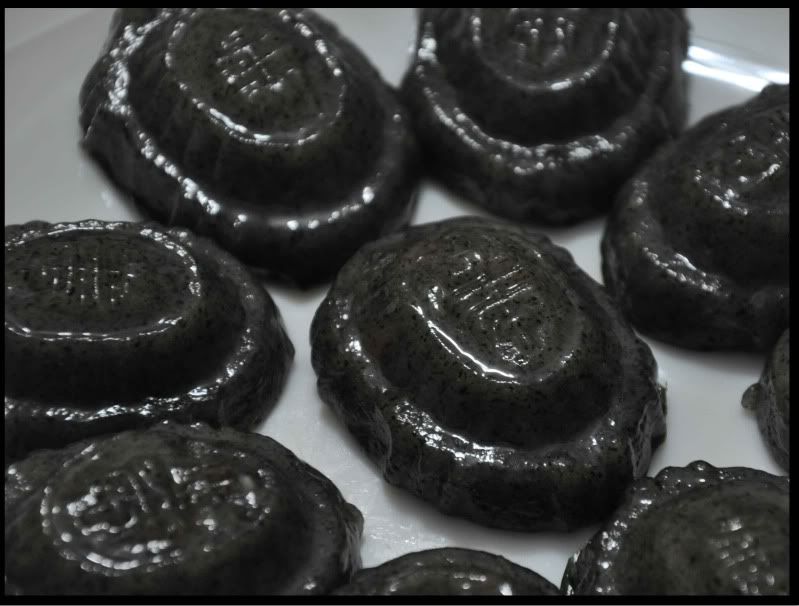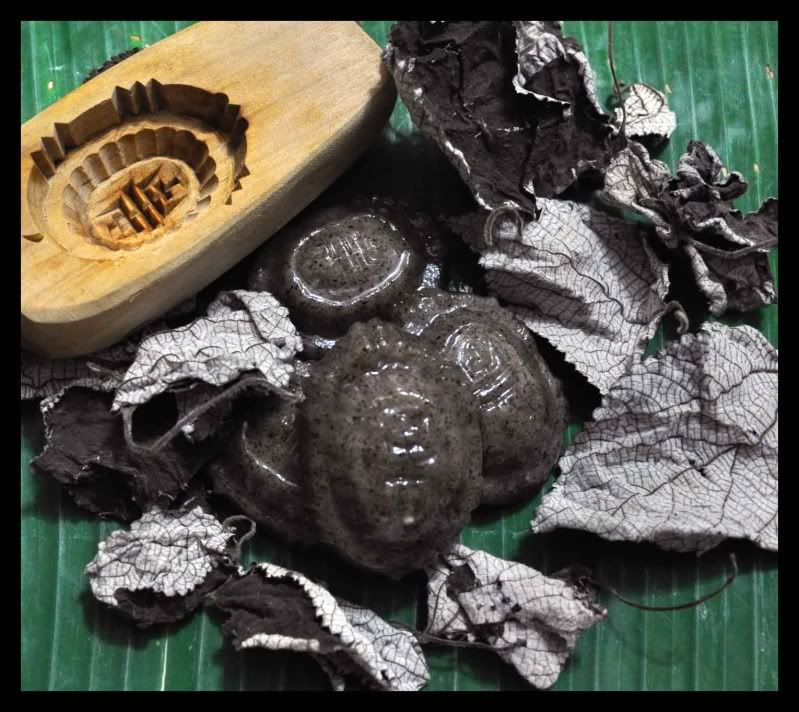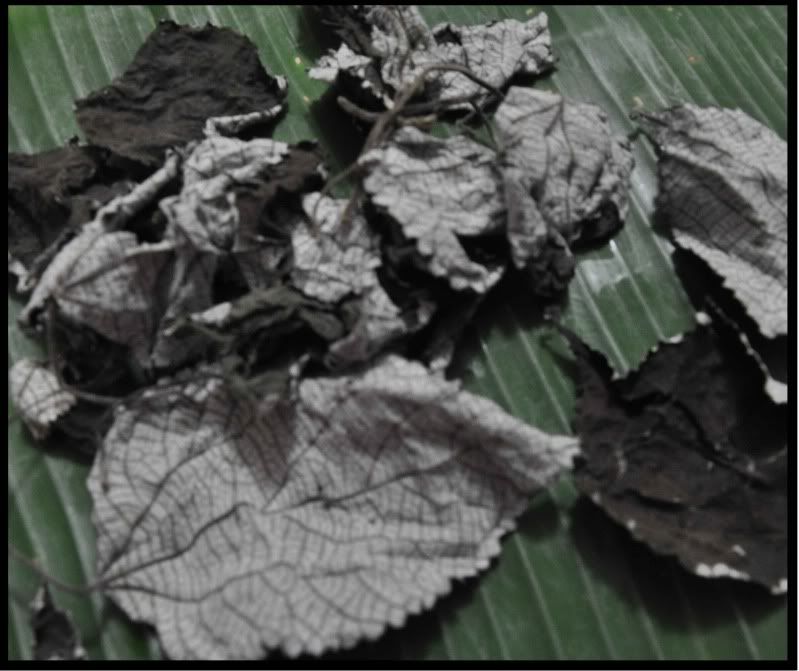The mini Kus, each measuring 6cm long and 4.2cm across.


The 'Orh' (Black) Ku Kueh or Black Tortoise Cake which I have here could have been a Hakka snack. I am just guessing as these black ku kueh gets it black hue from the leaves of the Rami, Choy Yip or Mugworts plant. These leaves are favored by the Hakkas and widely used in their traditional cakes to give them their distinctive black and I believe, for their medicinal properties too!
Anyway,this is the second time that I have attempted this kueh and the skin is much softer than the first attempt which was more chewy. I had added a spoon of rice flour to reduce the chewiness that comes from a skin made with 100% glutinous rice flour. Some recipes for the sweet Kus has mashed sweet potatoes or yam added to give the skin a softer bite while retaining the chewiness.
These black Kus are different from the usual Red, Purple, Yellow or Green Kus as it uses a savoury fillings of chai por (preserved radish) and minced pork which is fried till fragrant and then given a kick with liberal doses of white pepper. The skin however is sweet. In fact, the skin is much sweeter than the sweet ku kuehs. I suppose this is tactical to give the snack an interesting balance of taste from the salty preserved radish.
Fresh or dried, tt is quite difficult to find mugwort leaves here in Singapore. I got the dried leaves shown here from Johor Bahru. The fresh leaves are even more difficult to come by unless you are living in areas where there is a large community of Hakkas.

Traditional Black Angku
Filings:
100g minced chai poh, soaked to remove excess salt
100g minced pork
Seasonings:
1/2 tsp sugar
1 tsp dark soy sauce
1/2 tsp pepper
Marinade:
1/4tsp salt
1 tsp soy sauce
1/2 tsp sesame oil
1) Mix the marinade with the pork and leave in the fridge for one hour.
2) Heat a work with a little oil and saute chai poh till fragrant, then add the minced pork and seasonings. Drizzle in a little water and stir fry well. Dish up and cool.
Skin:
150g choh yip/fresh rami leaves
130g caster sugar
200g glutinous rice flour
25ml cooking oil
125-150ml water
Glazing:
2 tbsp pre-cooked oil
Banana leaves cut into shapes slightly bigger than the mould you intend to use. Brush leaves with oil.
Method:
1) Wash the rami leaves and boil with water for 30 minutes. Remove, drain off excess water and leave aside to cool before blending into a paste.
2) Place the glutinuous flour into a mixing bowl.
3) Boil the water and sugar till melted. Add in the paste and stir to distribute the paste.
4) Pour the hot syrup into the glutinous flour and quickly stir into a dough.
5) Place the hot dough onto a clean table, add the oil and knead till you get a smooth and shiny dough.
6) Scale dough into pieces and roll into ball.
7) Flatten each piece and wrap with the fillings, seal the edges and roll into a ball.
8) Dust with extra glutinous flour before placing into the mould. Press the ball into the mould with your palm and knock the mould to dislodge the kueh. Place on a greased banana leaf.
9) Steam over low flame for five minutes, uncover steamer cover, glaze kueh with cooked oil, Cover and steam for another 2 minutes.
Note:
The original recipe suggested to 'wash' off the excess glutinuous flour from the shaped kueh under a tap (slow water). I did not do it as I use minimal flour to dust the kueh.
As I mentioned, I added some rice flour for a softer skin. What I did was to remove 1/2 tbsp of glutinuous flour and replace with 1/2 tbsp of rice flour.
I used 10gms of dried choh yip which has been soaked overnight to soften before boiling. I cut off the hard stems before weighing the leaves and also to avoid having hards bits of stems in the skin.
You may wish to reduce the sugar for the skin, I find it too sweet.
8 comments:
http://makebakingfun.aceboard.com/
Do visit, Newly open forum
Hi stumble upon your blog while looking for this recipe. Mum has the mugwort freshly dried wants to make this orh ku kueh. Can you share the recipe?
Hi iml
I have posted the recipe above.
Ginny
Excellent post ! I've a minu Kus. I love this kind of cakes, they're very original and delicious. I'm going to find the right mold to make it at home.
It won't truly have success, I believe so.
Hi Rusti,
I am finding this type of leave for a such a long time. I found a leaf look like what you post, but i am not sure it is the correct one. It has some hairy on the surface and got a special smell. Is it the correct one?thanks
The original recipe may be found in
Wong Sip Moi: Old-Fashioned Kuih-Muih,
Y Three K Publisher, Kuala Lumpur, 2006
Post a Comment